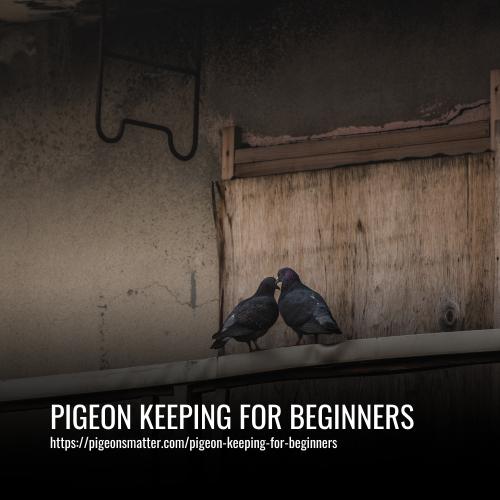To get started with pigeon keeping, begin by researching different pigeon breeds and their care requirements. Once you have decided on the type of pigeon you want to raise, acquire a pair or small flock from a reputable breeder.
Next, set up a suitable pigeon loft with proper ventilation, nesting boxes, perches, and feeding and watering stations. Provide your pigeons with a balanced diet that includes pigeon feed, grains, and fresh fruits and vegetables. During cold months, bring the pigeons indoors or provide a heat source for them outside.
Pigeons also need exercise, so it’s important to let them out of their cages to walk around or fly for some time. Additionally, don’t worry about your birds escaping, as the constant food and water supply at their cage will always bring them back. With the right knowledge and preparation, raising pigeons can be a rewarding experience.

Popular Pigeon Breeds
1. Racing Homers:
- – Fast and agile fliers.
- – Used for racing competitions.
- – Can cover long distances easily.
2. Fancy Pigeons:
- – Bred for a distinctive appearance.
- – Exhibited in pigeon shows.
- – Come in a variety of colors and patterns.
3. King Pigeons:
- – Large and docile breed.
- – Make excellent pets.
- – Kept for their friendly nature and appearance.
4. Fantails:
- – Known for fan-shaped tail feathers.
- – Exhibited in pigeon shows.
- – Come in a variety of colors.
5. Jacobins:
- – Distinctive head feathers form a hood.
- – Exhibited in pigeon shows for unique appearance.
6. Carrier Pigeons:
- – Historically used for carrying messages.
- – Strong homing instinct.
- – Can navigate over hundreds of miles.
7. Tumblers:
- – Known for acrobatic abilities.
- – Can perform aerial maneuvers like somersaults and spins.
Caring for Pigeons
- Nutrition: Provide a balanced diet of grains, seeds, and protein sources. Offer fresh water daily.
- Housing: Keep pigeons in a clean, dry, and well-ventilated space. Protect them from predators and the elements. Regularly clean housing to prevent disease.
- Health Check-ups: Schedule regular check-ups with a veterinarian. Address any signs of illness, injury, or abnormal behavior promptly.
- Hygiene: Maintain a clean living environment to prevent disease. Regularly clean housing and feeding areas. Properly dispose of waste.
- Exercise: Provide regular exercise for physical and mental well-being. Free-flight training, release and return flights, or use of aviaries.
- Socialization: Keep pigeons in breeding pairs or small groups for social stimulation. Caring for pigeons involves providing a balanced diet, a clean living space, regular health check-ups, hygiene maintenance, exercise, and socialization for their well-being.
Taking Care of Baby Pigeons:
When caring for a baby pigeon without a parent, it’s important to feed it a proper diet recommended by a veterinarian, such as a commercial baby bird mixture. Use a syringe to feed the bird 2-3 times per day until it is 5 days old, then switch to a larger syringe until it is 3 weeks old. At 3 weeks, introduce seeds into its cage for it to start learning to feed itself, while still providing water from a syringe until it is a month old. By six weeks, the pigeon will no longer be a baby and will require care similar to an adult pigeon. Remember to clean the syringe with hot boiling water after each use to prevent infection.
Preparation Of Pigeon Housing:
When preparing to house pigeons, it’s important to create a safe and comfortable environment. Set up a suitable pigeon loft with proper ventilation, nesting boxes, perches, and feeding and watering stations. Make sure the loft is large enough so that the birds can move around freely.
1. Loft:
- Construct a dedicated space for pigeons to live and roost, using materials like wood or concrete.
- Ensure proper ventilation, insulation, and lighting for the loft.
- Build in various sizes and styles based on the number of birds.
2. Aviary:
- Create a large, enclosed space for pigeons to fly and move around freely.
- Construct with wood, wire mesh, or other materials for ample space.
- Use for breeding, racing, or as a larger living space for the birds.
3. Coop:
- Use a smaller housing structure for a few pigeons, either portable or stationary.
- Construct with materials like wood or plastic.
- Ideal for keeping a small flock of pigeons for pets or hobby breeding.
4. Nesting Boxes:
- Provide safe and comfortable spaces for pigeons to lay their eggs and raise their young.
- Place in the loft or aviary using durable materials like wood.
Overall, the housing should prioritize safety, comfort, and health for the pigeons, regardless of which type of structure is chosen.
Feeding and water facilities for squabs and pigeons
For feeding and providing water to squabs and pigeons, it is important to offer a simple diet of whole grains, good hard grit, and plenty of fresh, clean water. The old birds begin immediately to feed the young, known as squabs, with a fluid called “Pigeon Milk,” which is a combination of secretions from the parents’ crops and partially digested feed. The young grow rapidly on this diet. It is important to ensure that the feed, grit, and water are placed in containers spaced some distance apart, and these containers should be designed to prevent dirt or filth from contaminating the feed and water.
Pellets specially made for pigeons are available, but it is cautioned that feeding only pellets can cause loose droppings in pigeons. It is also recommended to employ cafeteria-style feeding, where each feed ingredient is placed in a separate container, allowing the bird to choose and satisfy its desires. This style of feeding prevents waste feeders and is beneficial for beginners. Additionally, feeders or other receptacles for pigeon feed should be kept protected from the weather by placing them inside the coop or pen rather than outside.
Pigeon Breeding
Pigeon Breeding is an activity that has long been enjoyed by pigeon keepers all over the world. The process of breeding pigeons requires careful planning and diligence to ensure success.
1. Selecting Breeding Pairs:
– Choose birds based on genetics, health, and temperament.
– Look for complementary strengths and weaknesses.
2. Breeding Cycle:
– Manage breeding cycles with lighting and temperature control.
– Provide space, nesting materials, and a comfortable environment.
3. Incubation and Hatching:
– Eggs take 17-19 days to hatch.
– Chicks require warmth and protection from parents.
– Allow enough time for incubation and raising young.
4. Health and Hygiene:
– Keep pigeons in a clean environment to prevent disease.
– Regular vet check-ups ensure the health of breeding pairs and offspring.
How To Train the Pet Pigeon?
To train a pet pigeon, it is important to establish and enforce rules to ensure their safety and health. Untrained pigeons may act rebelliously, such as refusing to enter their cage or coop, sleeping outside, or consuming harmful substances.
To train them, effective methods include not feeding the rebellious pigeon and only feeding the others, not allowing them outside during exercise time, and not letting them inside as a form of discipline.
These methods teach the pigeon that not following rules will result in no food or playtime. It’s important to note that training methods can vary for each pigeon and person. By carefully implementing these methods, pet pigeons can be tamed and kept safe and healthy.
Purpose of Raising Pigeons
- Raising Pigeons As Pets: Pigeons can be friendly and entertaining pets, providing companionship and enjoyment to their owners.
- Raising Pigeons For Racing: Pigeon racing is a popular sport in many countries, where pigeons are trained to fly long distances and compete against other pigeons.
- Raising Pigeons For Show: Pigeon shows and exhibitions allow breeders to showcase their birds and compete for awards and prizes.
- Raising Pigeons For Meat Production: In some regions, pigeons are raised for their meat, which is considered a delicacy.
- Raising Pigeons As Messenger Birds: Historically, pigeons have been used as messenger birds due to their ability to navigate over long distances and deliver messages quickly.
- For Conservation: Some individuals raise and breed rare and endangered pigeon species to help preserve them and prevent their extinction.
Advantages of Raising Pigeons
Raising pigeons has numerous advantages. Pigeons are prolific breeders, producing up to 12 pairs of eggs in a good pair, with nearly all eggs successfully hatching. The resulting baby pigeons can be sold or consumed within 4 weeks. Pigeons are low maintenance and can be kept with other household birds.
They require minimal feeding, can find their food, and can be raised in a small space, even in a hanging basket. Pigeons mature and start laying eggs in 5-6 months, and their meat is suitable for patients. Pigeons also have a short gestation period of 18 days. Additionally, joining a local pigeon club or association can provide valuable knowledge and connections. Attending pigeon shows and competitions can further enhance breeding and exhibiting skills.
However, it’s important to regularly monitor the health and behavior of the pigeons and seek veterinary care as needed. Dedicate time and effort to provide proper care and attention, and enjoy the fulfillment of raising and breeding these fascinating birds. Remember that raising pigeons requires a commitment of time, resources, and knowledge, but with proper care, they can thrive and provide years of enjoyment.
Interesting Facts About Raising Pigeons
Raising pigeons involves various interesting aspects. Pigeon racing is a popular sport that involves breeding and training homing pigeons to compete in races covering distances of up to 1000 kilometers, with some reaching speeds of up to 120 kilometers per hour. Pigeon droppings, or “guano,” are a valuable fertilizer rich in nitrogen, leading to a major guano mining industry in some countries.
Pigeons have been used for centuries as messengers and were extensively used during World War I and II for communication. Their highly developed sense of direction is useful for scientific studies on animal navigation and migration. Pigeons can live up to 15 years in captivity with proper care and nutrition.
They are highly intelligent and can learn to recognize and respond to human voices and commands, as well as be trained for racing, tricks, or message delivery. Pigeon breeding and racing is a hobby enjoyed by millions worldwide, with enthusiasts forming close-knit communities.
Best Tips for Raising Pigeons
Raising pigeons can be a rewarding experience, but it requires commitment and dedication. Here are some tips to help you get started:
1. Provide a Clean and Ventilated Living Environment:
- Regularly clean housing and feeding areas to prevent disease and keep pigeons comfortable.
- Ensure good ventilation for their health and well-being.
2. Feed a Balanced Diet:
- Give pigeons a balanced diet of grains, seeds, and protein sources.
- Provide fresh water daily for their nutrition and hydration.
3. Regular Exercise:
- Give pigeons regular exercise, such as free-flight training or use of aviaries.
- This helps maintain their physical and mental well-being.
4. Regular Health Check-ups:
- Schedule regular check-ups with a veterinarian to ensure their health and well-being.
- Promptly address signs of illness, injury, or abnormal behavior.
5. Provide Socialization:
- Keep breeding pairs or small groups of pigeons together for social stimulation.
- Pigeons are social animals and require companionship to thrive.
6. Protect From Predators:
- Protect pigeons from predators like cats, hawks, and raccoons with fencing or netting.
- Ensure their living environment is safe from potential threats.
7. Learn About Pigeon Behavior:
- Understand natural pigeon behavior for better care and training.
- Anticipate and address potential issues by learning about pigeon communication, breeding habits, and social hierarchy.
FAQs
Beginners often find breeds like Homers or Rollers ideal due to their adaptability, calm temperament, and ease of care. Homing pigeons (Homers) are popular for their navigation abilities, while Roller pigeons are known for their acrobatic flights.
A basic loft or coop with enough space for pigeons to fly and roost comfortably is essential. Ensure proper ventilation, nesting boxes, perches, and protection from predators. Start with a simple setup, gradually expanding as you gain experience.
Pigeons typically require feeding twice a day, offering a mix of grains and pigeon feed available at pet stores. Additionally, they benefit from access to grit and clean water at all times.
Training pigeons to return home involves gradually releasing them from short distances and rewarding their successful returns with treats. Repeat these training flights, increasing distances over time as they become more familiar with their home.
Regular cleaning of the loft, providing fresh food and water, and keeping an eye on signs of illness or parasites are crucial. Consult a veterinarian specializing in birds for routine check-ups and vaccinations.
Yes, you can keep pigeons in urban areas if local regulations permit. Indoor keeping requires adequate space, proper ventilation, and hygiene considerations. However, outdoor setups are more common due to the space requirements and natural flying behaviors of pigeons.
Conclusion:
Pigeon keeping may seem like an unusual hobby, but it can bring so much joy and fulfillment to your life. Whether you’re a beginner or an experienced bird lover, starting and caring for a flock of pigeons can be a rewarding and fascinating experience.
So, spread your wings and dive into the world of pigeon keeping – you’ll be amazed at the incredible bond that can form between you and these remarkable birds. Happy pigeon keeping!


